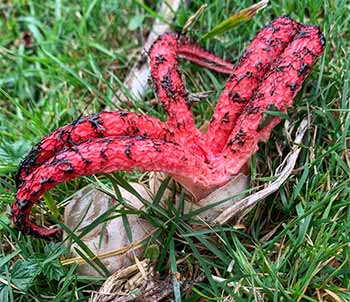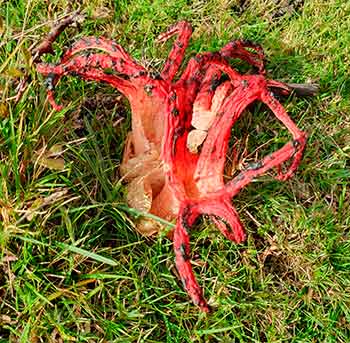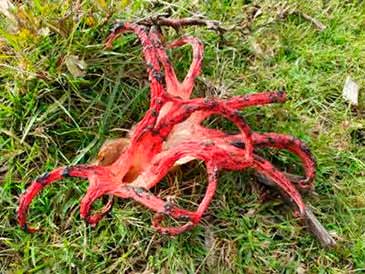Devil's Fingers (Clathrus archeri)

(Many thanks to Victoria Hughes for the image)
Devil's Fingers: what a name for a fungus! But it's very descriptive and absolutely appropriate for this is a fungus with usually between four and eight strikingly pink to reddish, slender, pointed, sometimes branched, spore-bearing, tentacle-like fingers that are initially joined at the tip and arched, but soon separate, spread and droop.
The 'tentacles' sprout from an elongated, sub-spherical, gelatinous, whitish-ochre 'egg', 4 - 6 centimetres high by 2 - 4 centimetres wide, that in part lies buried in the soil, grass or whatever other substrate supports the fungus. The 'egg' is in turn attached by a thickish cord-like structure to an underground network of branching threads more properly known as a mycelium.
Devil's Fingers are closely related to the Common Stinkhorn (Phallus impudicus), which is a well-known New Forest woodland fungus, and the somewhat scarcer Dog Stinkhorn (Mutinus caninus).
And as with these stinkhorns, Devil's Fingers produce a sticky, foul-smelling, spore-bearing substance that has evolved to attract flies, beetles and slugs which inadvertently carry away the spores that attach themselves to the creatures and in-so-doing, act as extremely effective dispersal agents.
(It may well be that in the New Forest, commoners' stock and deer also help to distribute the spores that potentially attach to their hooves, although how this can be proved or disproved is a moot point).

(Many thanks to Stephen Boswell for the image)
The spore-bearing tissue - the gleba - is often unflatteringly likened to slime, and is borne on the inner face of the 'tentacles'. The gleba is initially pale, quite quickly turns olive-brown or green, and then darkens at maturity.
And again, as with Common and Dog Stinkhorns, Devil's Fingers can remain at the 'egg' stage for a number of weeks, eventually showing traces of the colour and outline of the 'tentacles' within, waiting for exactly the right conditions before the 'egg' ruptures and allows the 'tentacles' to emerge and within a few hours grow to full size. The 'tentacles', however, once they have emerged, usually quite quickly lose their freshness.
Also known as the Octopus Fungus and sometimes also referred to as the Squid Fungus, Devil's Fingers are not European natives but instead hail from Australia and New Zealand. It is thought that they were accidentally introduced into Europe during the First World War, possibly with imported timber or other military supplies.
According to the Royal Botanic Gardens, Kew, the first European record came from France in 1914, whilst the fungus was first noted in Britain in Penzance, Cornwall, in 1946.
The first New Forest report came at around the turn of the millennium, whilst Devil's Fingers are now found in many southern counties and elsewhere a little farther north. Range expansion is continuing and individual populations also appear to be increasing.

(Many thanks to Stephen Boswell for the image)
Within their UK range, Devil's Fingers have been described as 'locally frequent, especially favouring wood-chip mulch'. They typically grow in clusters and are widely distributed in the New Forest where they are increasingly found on open, short-cropped grasslands, sometimes amongst scattered gorse and bracken; and in broad-leaved woodlands and occasionally amongst conifers, around old tree stumps, in the soil or within leaf litter.
Devil's Fingers are not toxic and are quite harmless, but their unpleasant texture and odour renders them largely inedible. And unlike many introduced aliens, they are not considered to be of conservation concern (yet)!
Warning: refer to a good, comprehensive fungus field guide to confirm identification, and only eat those species known without any doubt whatsoever to be edible - people have died after eating certain poisonous specimens.
References:
UK Fungi
First Nature
The Mushrooms and Toadstools of Britain and North-western Europe - Marcel Bon
Fungi of Britain and Europe - Stefan Buczacki and John Wilkinson
More links
Search this site

Sadly, 58 animals were killed - 35 ponies, 13 cows, 8 donkeys and 2 sheep, whilst a further 32 were injured - 3 pigs, 9 donkeys, 11 cows and 9 ponies.
(Forty-three accidents occurred in daylight, 15 at twilight and 101 in the dark. Twenty-seven accidents were not reported by the driver involved).
Here's just one horrific example - Three donkeys killed in collision with van at notorious New Forest blackspot (Advertiser and Times)

